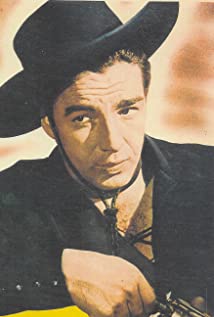He looked so much like superstar Humphrey Bogart that character actress Sarah Padden asked if the two were related. LaRue said he didn't think so. After a long pause studying the young actor's face, she asked, "Did your mother ever meet Humphrey Bogart?"Alfred "Lash" LaRue was born in Louisiana (although some records indicate Michigan). His father was a traveling salesman, and young Alfred spent his formative years moving all across the country. His family finally settled in Los Angeles where he attended St. John's Military Academy and began college at College of the Pacific, intending to study law. At some point he took an acting class there in an attempt to overcome a speech impediment. After college he followed his father into sales and became a real estate agent. Unsatisfied, he switched to hairdressing before falling into acting. In 1945 he was interviewed by veteran low-budget producer / director Robert Emmett Tansey, who was looking for a bullwhip-cracking anti-hero to co-star in a production at lowly Producers Releasing Corporation (PRC). That studio had been around since 1940, rising out of the ashes of Ben Judell's failed dream, and had quickly earned a reputation--entirely justified--of being the worst studio among the denizens of "Poverty Row", that grouping of cheap jack independent producers and ultra-low-budget production companies which composed the bottom rung of the Hollywood food chain, at least since the days of equally shoddy Syndicate Pictures a decade before. LaRue, with his remarkable resemblance to Bogart, certainly looked the part and was cast after claiming he had worked a bullwhip since childhood. In fact he had never handled one, so after he was cast he ran out and borrowed a whip. He spent the next several days trying to learn to use it, but wound up beating himself senseless and bloody, and was finally forced to admit to Tansey that he didn't know what he was doing. Impressed by LaRue's sincerity and laughing at his injuries, Tansey arranged for personalized bullwhip instruction, a rather lavish expense for penny-pinching PRC. Al had appeared in a handful of walk-on roles at Universal, but after realistically gauging his chances at becoming a star at a major studio, he decided it was better to be a bigger fish in a small pond (or, in PRC's case, a mud puddle). His PRC debut, Song of Old Wyoming (1945), headlined singing cowboy Eddie Dean and co-starred the beautiful Jennifer Holt, veteran actor Jack Holt's daughter. This picture was also unique as being PRC's first western to be shot in color, albeit in Cinecolor, a process favored by low-budget producers because it was much cheaper than the better known (and more garish) Technicolor, even though it was decidedly inferior and gave films shot in it an anemic, washed-out look.Although he wasn't the star, and billed as "the Cheyenne Kid," LaRue received a relatively large amount of fan mail where it then dawned on the powers-that-be at PRC they had a potential star on their hands. Not wanting to mess with a good thing, the studio paired the whip-cracking LaRue with the singing Dean two more times before splitting them off into their own pictures. LaRue quickly adopted an all-black wardrobe and rode a jet black horse to accentuate his image as a bad guy / good guy, sort of an early western anti-hero. He was assigned a sidekick, the hard-drinking, middle-aged Al St. John--a former Keystone Kop for Mack Sennett--beginning with Law of the Lash (1947) and the two gradually became good friends. At PRC he became "King of the Bullwhip" and a solid staple of Saturday-afternoon matinees. LaRue remained with the company after it morphed into Eagle-Lion in 1948, usually playing a character named Cheyenne Davis, before adopting the "Lash" moniker he'd been using for years in screen credits. In private life LaRue loved booze, women and flashy--preferably custom-tailored--clothes. He was married so often it was hard to keep track of his wives, but most sources agree that the number ranged from 10 to 12, two of his more notable ones being actresses Reno Browne, a blonde beauty who co-starred in a few of his films, and Barbra Fuller. Aside from a penchant for marrying pretty much anyone he became attracted to, he also acquired an alcohol problem (which he would battle, with varying degrees of success, for the rest of his life) and after his acting career waned in the early '50s he ran into financial problems. Despite having one of the more recognizable names in B-westerns, he never ranked among the top stars in popularity polls, probably attributable less to his screen persona or acting ability and more to his films' awful scripts and deplorable lack of production values due to PRC's legendary cheapness, a factor which hurt the careers of many of the studio's western stars (had he been signed to a less penurious studio like Republic or Columbia, his career might have risen to far greater heights). LaRue almost always performed his own stunts--mainly because PRC was loathe to spend money on professional stunt men, who in those days demanded higher pay than the stars they were doubling for--a fact he took pride in and made sure that he "conveniently" lost his hat during action scenes so his audience could see that it was actually him in the fray and not a stunt double.It's interesting to note that although he was never a top-ranked cowboy star during his heyday, he rated his own comic book series that lasted until 1960. After riding out a particularly rough period of his life in the 1960s, he began appearing at Hollywood memorabilia and western shows where he cheerfully greeted fans, happily signed autographs and gained a reputation of being pleasantly accessible. He died in 1996.
Show less «



